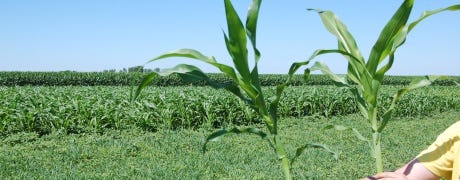
Corn plants that emerge late will likely develop late all season. This is certainly true of late emergers within the row, notes Jeff Phillips, Tippecanoe County Extension ag educator.
It's also true if a whole field emerges later than it should. Plots at the Purdue University Throckmorton Research Center a couple of years ago proved the point. The study was part of an Indiana Prairie Farmer and Precision Planting project. The goal was to determine if planting depth made a difference.

Plant proof: Note the plant on the right. It is from a strip planted at the one-inch depth, vs. the plant from a plot planted at a deeper depth on the left. The smaller plant matured more slowly all season long.
Corn planted one inch deep started to germinate, but then didn't have enough moisture to finish. Seed placed 2-4 inches deep had enough moisture and germinated before soils dried out. The plots were planted during the third week of May. Rain a week after planting aided the one-inch deep seeds, but some had already succumbed.
So while you would have expected seed planted 4 inches deep to emerge last and unevenly, that wasn't the case, Phillips notes. You couldn't have distinguished which trial plots were which within a plot map, he says. You would have likely guessed that the tallest, most uniform plots were planted an inch deep, and you would have had the plot exactly backwards. There was little difference for plants emerging from 2, 3 and 4 inches deep, he notes. However, the soils were warm when the crop was planted.
Don't try this with soybeans, Shaun Casteel says. The Purdue Extension soybean specialist recently pointed out that when soybeans are planted more than 2 inches deep, even if it is an attempt to get the seed into moisture, they typically encounter problems. The hypocotyl may break or one or more cotyledons may rip off in the process. Two inches is the maximum depth for planting soybeans, he concludes.
Once behind, always behind
Based on the observations in the Purdue plots during the trial, the corn at 1 inch deep remained behind all the way to harvest. When the rest of the plots were at V 7, with seven leaf collars fully exposed, the one-inch corn was still at V 4 to V5. The growing point comes above the ground at about V5.
The effect was still noticeable at harvest, both visually and in the combine tank. In fact the one-inch deep corn yielded about 20 bushels per acre less than corn planted at any of the other depths. It was significantly lower. However, Phillips notes that finding was only for that year in that situation.
About the Author(s)
You May Also Like




